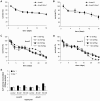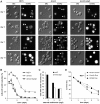Lifespan extension by methionine restriction requires autophagy-dependent vacuolar acidification
- PMID: 24785424
- PMCID: PMC4006742
- DOI: 10.1371/journal.pgen.1004347
Lifespan extension by methionine restriction requires autophagy-dependent vacuolar acidification
Abstract
Reduced supply of the amino acid methionine increases longevity across species through an as yet elusive mechanism. Here, we report that methionine restriction (MetR) extends yeast chronological lifespan in an autophagy-dependent manner. Single deletion of several genes essential for autophagy (ATG5, ATG7 or ATG8) fully abolished the longevity-enhancing capacity of MetR. While pharmacological or genetic inhibition of TOR1 increased lifespan in methionine-prototroph yeast, TOR1 suppression failed to extend the longevity of methionine-restricted yeast cells. Notably, vacuole-acidity was specifically enhanced by MetR, a phenotype that essentially required autophagy. Overexpression of vacuolar ATPase components (Vma1p or Vph2p) suffices to increase chronological lifespan of methionine-prototrophic yeast. In contrast, lifespan extension upon MetR was prevented by inhibition of vacuolar acidity upon disruption of the vacuolar ATPase. In conclusion, autophagy promotes lifespan extension upon MetR and requires the subsequent stimulation of vacuolar acidification, while it is epistatic to the equally autophagy-dependent anti-aging pathway triggered by TOR1 inhibition or deletion.
Conflict of interest statement
The authors have declared that no competing interests exist.
Figures






Comment in
-
Autophagy extends lifespan via vacuolar acidification.Microb Cell. 2014 May 5;1(5):160-162. doi: 10.15698/mic2014.05.147. Microb Cell. 2014. PMID: 28357240 Free PMC article.
References
-
- Orentreich N, Matias JR, DeFelice A, Zimmerman JA (1993) Low methionine ingestion by rats extends life span. J Nutr 123: 269–274 Available: http://www.ncbi.nlm.nih.gov/entrez/query.fcgi?cmd=Retrieve&db=PubMed&dop.... - PubMed
-
- Lopez-Torres M, Barja G (2008) Lowered methionine ingestion as responsible for the decrease in rodent mitochondrial oxidative stress in protein and dietary restriction possible implications for humans. Biochim Biophys Acta 1780: 1337–1347 Available: http://www.ncbi.nlm.nih.gov/entrez/query.fcgi?cmd=Retrieve&db=PubMed&dop.... - PubMed
-
- Caro P, Gomez J, Sanchez I, Naudi A, Ayala V, et al. (2009) Forty percent methionine restriction decreases mitochondrial oxygen radical production and leak at complex I during forward electron flow and lowers oxidative damage to proteins and mitochondrial DNA in rat kidney and brain mitochondria. Rejuvenation Res 12: 421–434 Available: http://www.ncbi.nlm.nih.gov/entrez/query.fcgi?cmd=Retrieve&db=PubMed&dop.... - PubMed
-
- Gomez J, Caro P, Sanchez I, Naudi A, Jove M, et al. (2009) Effect of methionine dietary supplementation on mitochondrial oxygen radical generation and oxidative DNA damage in rat liver and heart. J Bioenerg Biomembr 41: 309–321 Available: http://www.ncbi.nlm.nih.gov/entrez/query.fcgi?cmd=Retrieve&db=PubMed&dop.... - PubMed
-
- Sanz A, Caro P, Ayala V, Portero-Otin M, Pamplona R, et al. (2006) Methionine restriction decreases mitochondrial oxygen radical generation and leak as well as oxidative damage to mitochondrial DNA and proteins. FASEB J 20: 1064–1073 Available: http://www.ncbi.nlm.nih.gov/entrez/query.fcgi?cmd=Retrieve&db=PubMed&dop.... - PubMed
Publication types
MeSH terms
Substances
Grants and funding
LinkOut - more resources
Full Text Sources
Other Literature Sources
Molecular Biology Databases

